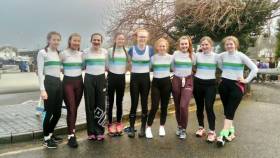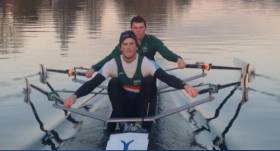Displaying items by tag: Head of the Shannon
Shannon Navigation: ‘Head of the Shannon’ Rowing Event in Carrick-on-Shannon This Saturday
Waterways Ireland advises all masters of vessels and waterway users on the Shannon Navigation that the Head of the Shannon rowing event will take place in Carrick-on-Shannon this Saturday 3 December.
The event will take place downstream of Carrick bridge for a distance of 3.5km. The rowing starts at navigation maker known locally as White Woman/White Lady downstream of Carrick-on-Shannon and will proceed back to the Marina just downstream of the bridge.
The rowing events will take place between 10am and 4pm. Masters of vessels are requested to proceed with additional caution in the vicinity of the rowing events during these times.
This event is the second Head of the Shannon of 2022, as last year’s event was postponed until February. Details for competing rowers can be found HERE.
Advisory for Water Users Around Rescheduled ‘Head of the Shannon’ Rowing Event Next Month
Waterways Ireland advises all masters of vessels and water users that the rescheduled Head of the Shannon rowing event will take place on Saturday 19 February.
The day’s events will take place at 11am and 2pm downstream of Carrick-on-Shannon bridge for a distance of 3.5km. The rowing starts at the navigation maker known locally as White Woman/White Lady and will proceed back to the marina downstream of the bridge.
Masters of vessels on the Shannon Navigation are requested to proceed with additional caution in the vicinity of the rowing events.
Caution Advised for Boaters Around ‘Head of the Shannon’ Rowing Event
Waterways Ireland wishes to advise all masters of vessels and water users that the Head of the Shannon rowing event will take place on Saturday 4 December.
The event will take place downstream of Carrick-on-Shannon bridge for a distance of 3.5km.
The rowing starts at navigation maker known locally as White Woman/White Lady and will proceed back to the Marina downstream of of the bridge.
Rowing events will take place at 11am and 2pm on the day.
Masters of vessels on the Shannon Navigation are requested to proceed with additional caution in the vicinity of the rowing events.
St Joseph's Shine at Head of the Shannon
St Joseph's of Galway were the fastest crew in the shortened second head at the Head of the Shannon rowing event in Carrick on Shannon today. The men's junior 18A eight rowed well and set a provisional time of nine minutes 19.3 seconds.
Commercial's men's junior 18A quadruple were almost as fast, winning their class in nine minutes 22.6 seconds.
The fastest women's crew was the Commercial club one eight, while the Tribesmen/Athlone combination came home fastest of the mixed masters eights.
Brian Colsh of Sligo came home fastest of the junior men's single scullers; Molly Curry was the best women's junior single sculler.
The conditions were surprisingly good, with the water calmer as the afternoon went on.
Muckross Head Cancelled But Head of Shannon Set to Be Held
Muckross Head of the River, set for Saturday, has cancelled but rowing people will be glad to hear that the big Head of the Shannon event in Carrick-on-Shannon is set to go ahead.
The organising committee of Muckross Head said that the weather forecast led them to cancel on safety grounds
Enniskillen and Coláiste Iognáid Pick up Pennants at Carrick
#Rowing: The Head of the Shannon enjoyed good weather and an appreciative crowd at Carrick-on-Shannon on Saturday. The timing system encountered some difficulties. Neptune’s junior 18 quadruple were the fastest crew in the first head. The pennant for this class was granted in the second head and Enniskillen took it. The Fermanagh club had a set of wins at junior level, as did Coláiste Iognáid of Galway. Commercial’s junior 16 women’s eight also came out on top.
Head of the Shannon, Carrick-on-Shannon, Selected Results (Category winners)
Head One
Men
Eight – Jun 16: Col Iognáid. Masters: Neptune (d)
Four – Jun 18, coxed: Enniskillen
Pair – Sen: Galway. Jun 18: Enniskillen
Sculling
Quadruple – Jun 16, coxed: Sligo. Masters: Galway (e). Masters, coxed: Athlone (e).
Double – Sen: Portadown. Masters: City of Derry (d). Jun 18: Enniskillen
Single – Jun 16: Athlone (Carroll)
Women
Eight – Jun 18: Col Iognáid
Four – Club, coxed: Athlone
Sculling, Quadruple – Jun 18: Enniskillen
Double – Club: Carrick-on-Shannon. Jun 16: Commercial
Single – Club: Carrick-on-Shannon (Early). Jun 18: Enniskillen (Fee)
Head Two
Men
Eight, Jun 18: Portadown
Four – Masters, coxed: Athlone (b)
Sculling
Quadruple – Jun 18: Enniskillen
Double – Club: Enniskillen. Jun 16: Enniskillen
Single – Sen: Sligo (G Patterson). Jun 18: Carrick-on-Shannon (Early). Masters: Athlone (Gallen, f)
Women,
Eight
Club: Galway. Jun 16: Commercial. Masters: Tribesmen B (e)
Four – Jun 18: Col Iognáid.
Pair – Jun 18: Col Iognáid
Sculling
Quadruple – Jun 16, coxed: Sligo.
Double – Jun 18: Enniskillen
Single – Club: Carrick-on-Shannon (T Duggan). Jun 16: Carrick-on-Shannon (Murtagh).
Lightweight Queen's Crew Fastest at Shannon Rowing
#Rowing: A young Queen’s University lightweight quadruple were the fastest crew at the Shannon Head of the River at Carrick-on-Shannon on Saturday. The under-23 crew of Jordan Wilson, Miles Taylor, Ewan Murray and Harry Mahon took 11 minutes and 53 seconds to complete the course. Portora’s junior 16 eight also did well. Tiernan Oliver and Sam McKeown, in a senior double, almost matched their time. See Attached Results.
Head of the Shannon, Carrick-on-Shannon (Selected Results)
Head One:
Men
Eight – Jun 16: Portora 12 minutes 43 seconds.
Four – Jun 18, coxed: Portora 13:13.
Sculling, Quadruple – Jun 16, coxed: Carrick-on-Shannon 14:24. Double – Sen: Queen’s 12:46
Women
Eight – Club One: Commercial 14:29. Jun 18: Commercial 13:39
Sculling, Quadruple – Jun 18A: Portora 14:08.
Head Two:
Men
Eight – Novice: Commercial 14:55.
Sculling – Quadruple – Sen: Queen’s 11:53. Jun 18A, coxed: Portora 12:28
Single – Sen: Queen’s (T Oliver) 14:03. Jun 18A Carrick-on-Shannon (T Earley) 14:48.
Women
Eight – Inter: Commercial B 13:40. Jun 16: Portora 13:57.

























































